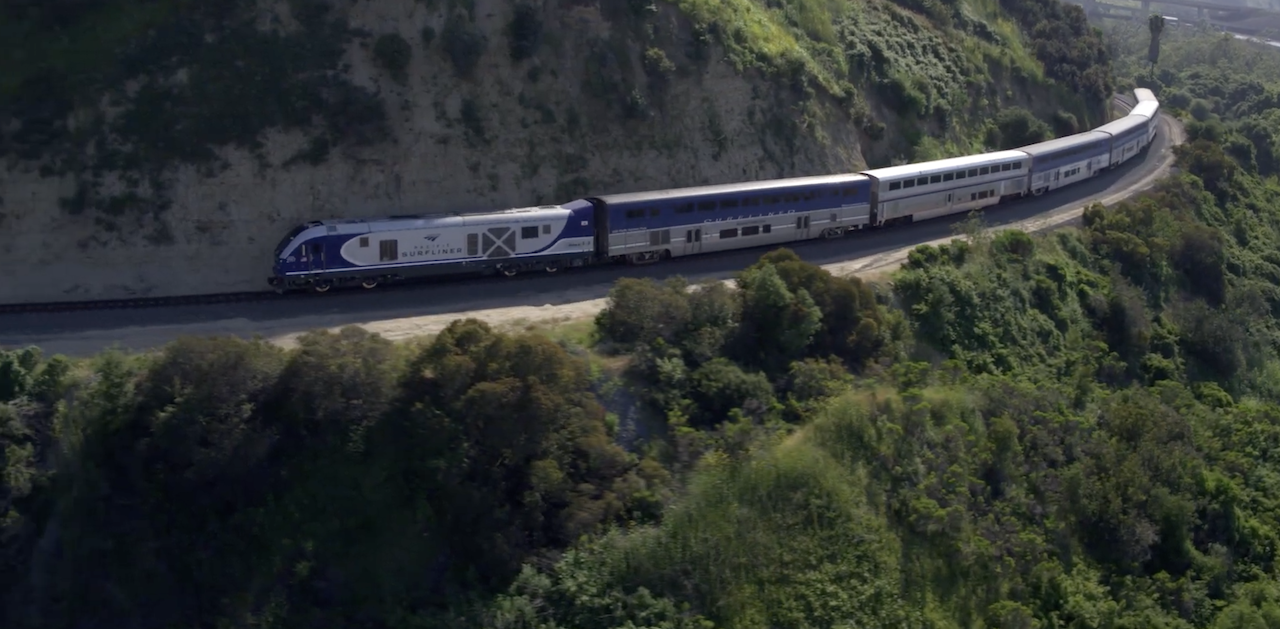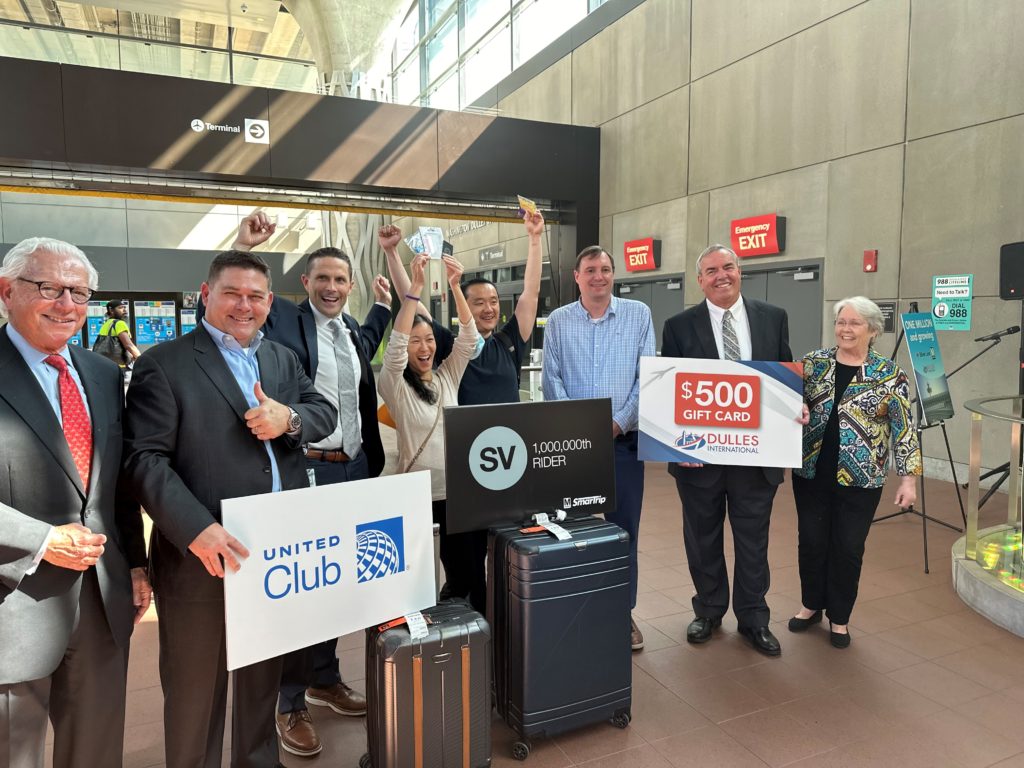
Transit Briefs: Amtrak/LOSSAN, NYMTA/PANYNJ, WMATA, Brightline
Written by Carolina Worrell, Senior Editor
Amtrak Pacific Surfliner service reduces fleet’s environmental impact with sustainable fuel alternative. Also, the New York Metropolitan Transportation Authority (MTA) announces that AirTrain JFK will accept payments via OMNY, beginning Oct. 11; the Washington Metropolitan Area Transit Authority (WMATA) celebrates one million customers at the Washington Dulles International Airport Silver Line Metrorail Station and announces that normal rail service has returned as the agency continues to inspect the fleet's oldest railcars; and Brightline will double its train service between Orlando and Miami.
Amtrak/LOSSAN
The Los Angeles–San Diego–San Luis Obispo (LOSSAN) Rail Corridor Agency, which manages the Amtrak® Pacific Surfliner® service, announced Oct. 3 that the passenger rail fleet is now powered by a more sustainable fuel alternative.
The Pacific Surfliner trains will now operate on renewable diesel (RD) which is chemically like fossil diesel but made from renewable raw materials such as cooking oil, instead of crude oil. Compared to fossil diesel, Amtrak says RD “significantly reduces greenhouse gas (GHG) emissions by an estimated 63% throughout its lifecycle, providing a steep increase to the sustainability of rail travel in Southern California.” Furthermore, the switch to RD, Amtrak says, o”ffers the potential to reduce other harmful emissions, including fine particulates and nitrogen oxides leading to improved local air quality.”
The adoption of renewable diesel for the Pacific Surfliner fleet is the result of a collaborative effort that engaged key stakeholders, including the California Department of Transportation (Caltrans), Amtrak, the Capitol Corridor Joint Powers Authority (CCJPA), San Joaquin Joint Powers Authority (SJJPA), and various other partners.
It is worth noting, Amtrak says, that the Pacific Surfliner is already an efficient mode of travel as train travel is 46% more energy efficient than traveling by car. Additionally, the Pacific Surfliner currently operates with the Cummins Tier IV-compliant QSK95 diesel-electric Charger, the first passenger locomotive to receive the stringent Tier IV emissions certification from the Environmental Protection Agency (EPA), making it “one of the cleanest diesel-electric passenger locomotives in operation,” according to Amtrak. “The transition to renewable diesel serves yet another significant stride in reducing the Pacific Surfliner and our passengers’ carbon footprint,” Amtrak said.
“The adoption of renewable diesel for our Pacific Surfliner service is an important milestone in our ongoing commitment to environmental preservation and the fight against climate change,” said Jewel Edson, Chair of the LOSSAN Agency Board of Directors. “We take immense pride in joining forces with Amtrak, state and federal agencies, rail equipment manufacturers, and fuel distributors who share our commitment to reducing greenhouse gas emissions and promoting sustainability.”
NYMTA/PANYNJ
The New York MTA, in partnership with the Port Authority of New York and New Jersey (PANYNJ) announced Oct. 4 that AirTrain JFK will begin accepting fare payments using the agency’s OMNY “Tap and Go” contactless payment readers, beginning Tuesday, Oct. 10.
OMNY will be available at select gates in both the Jamaica and Howard Beach stations, where an $8.25 one-way fare is required to enter or exit the system, and the AirTrain remains free for travel between airport terminals.
According to MTA, the new fare payment system will accept contactless debit/credit cards, digital wallets and OMNY cards. Fare gates that accept MetroCards will remain available and an option for customers. The initial installation of OMNY at the Jamaica and Howard Beach stations represents the first phase of the integration process. The number of OMNY-equipped gates will steadily increase over the next 15 months. By the end of 2024, MTA says, the OMNY “Tap and Go” contactless readers will be fully integrated into all fare gates.
“In September subway and bus customers tapped more than two million times on a single day, and now they’ll be able to use OMNY at the AirTrain JFK for much quicker passenger flow to and from the airport,” said MTA Chair and CEO Janno Lieber. “Whether you’re headed to catch a plane or returning home to New York, AirTrain riders can now take full advantage of this time-saving and seamless way to travel in the city.”
“We’re dedicated to enhancing every customer journey through our facilities and this integration of easy-to-use contactless payments at AirTrain JFK supports this commitment,” said PANYNJ Executive Director Rick Cotton. “Contactless payment systems like OMNY provide a tap-and-pay method that is convenient and quick for both our region’s residents and for travelers from other parts of the U.S. and from other countries.”
Cash customers, or those who do not have a contactless payment method, may purchase all currently available MetroCard products at MetroCard vending machines, Hudson News or Metro News, and then use MetroCard fare gates. Existing 30-day unlimited cards and discounted 10-trip cards for groups or frequent riders of AirTrain JFK are available through the AirTrain MetroCard that can be purchased at the stations’ MetroCard vending machines or at the news retailers on site.
Reduced-Fare customers who cannot use their Reduced-Fare MetroCard to swipe at AirTrain JFK gates can tap with the contactless payment device linked to their Reduced-Fare bank card or OMNY card at the AirTrain JFK’s OMNY readers and pay the full AirTrain fare.
AirTrain JFK stations are operational 24 hours a day, seven days a week with customer service agents available on site for assistance. OMNY market share of paid subway rides continue to be at or above 45%.
According to MTA, customers have tapped into the transit system over a billion times, with the billionth tap occurring on July 26. In the latest Spring 2023 Customers Count Survey, OMNY posted 79% fare payment satisfaction rate. Customers have tapped into all 472 subway stations and boarded 204 local bus routes and 31 express buses. OMNY has processed bank cards from each of the 195 countries that issues them.
WMATA
WMATA and the Metropolitan Washington Airports Authority (MWAA) on Oct. 4 commemorated a major milestone topping one million customers at the Washington Dulles International Airport Silver Line Metrorail Station since opening in November.
During a celebration event at the station, WMATA and MWAA surprised a lucky traveler as the ceremonial one-millionth customer to go through the Dulles Airport Station. Ivy Cheng arrived at the station greeted with cheers, Silver Line memorabilia and gifts provided by WMATA, Dulles International Airport and United Airlines.
Cheng and her traveling companion, Chao Pan, returned on an international flight from Japan. After using the high-speed rail on their travels, they were excited to take the Silver Line back home from the airport.

“What an exciting time for Metro and the Airports Authority to see the success of the Silver Line come to life,” said WMATA General Manager and CEO Randy Clarke. “This is the first of millions more who will take Metro to and from Dulles International Airport providing connectivity for people across the region and travelers around the world.”
According to WMATA, Total ridership passing through the agency’s six new Silver Line stations is now more than three million, with the Dulles Airport Station accounting for about a third of those customers who #RideSilver. On any given weekday, nearly 5,000 customers pass through the station, and more than 4,000 a day on average during the weekend.
“Today’s celebration is a testament to the success of the Dulles Airport Station, which is the most popular station on the Silver Line extension,” said Airports Authority President and CEO Jack Potter. “As we surpass the milestone of one million customers, we are grateful for the benefits of Silver Line service for airport customers, employees and airline business development opportunities, as well as all the transportation, business and environmental benefits it brings to our region.”
According to WMATA, the Silver Line has also given workers and travelers “an easier, more affordable, and sustainable way” to get to and from the airport, which serves more than 23 million airline passengers annually. Without WMATA, the agency says, about 70% of customers surveyed would have driven to the airport, taking those cars off the road and helping to reduce carbon emissions.
Today, WMATA provides service to 98 stations connecting Maryland, Virginia, and DC. The strong ridership at the Dulles Airport Station, the agency says, is also reflective of WMATA’s ridership gains, which continue to set pandemic-era records.
Separately, most Metrorail customers saw nearly normal train service on Oct. 2, even as the agency continues to inspect the fleet’s oldest railcars.
WMATA operated service to all customers (every 6-12 minutes from end-of-line stations); however Blue and Yellow line trains departed every 15 minutes while work continues to repair tracks damaged in the Sept. 29 derailment.
Track repairs are proceeding around the clock to replace components of the damaged tracks at National Airport.
According to WMATA, the investigation into the derailment continues, but agency found that the wheel measurements on the 7000-series train were “consistent with its specifications and there were no apparent track or infrastructure defects, as a preliminary matter.”
WMATA investigators, who are coordinating with the Washington Metrorail Safety Commission, continue to focus on a disc brake that came loose from a train ahead as a causal factor.
Following the Sept. 30 order from Clarke to remove all 2000- and 3000-series railcars from service, mechanical teams have inspected 102 cars and identified 32 with non-conforming bolts.
“We continue to act quickly on information as it develops to ensure safe and reliable train operations for our customers and employees,” said Clarke. “I am proud of the team for delivering solid service while tackling this challenge with our 35-year-old equipment.”
The Breda 2000- and 3000-series cars, built in the mid 1980s are reaching the end of their useful life and are scheduled to be replaced by new 8000-series railcars.
Brightline
Brightline announced Oct. 5 that it will double its train service between Orlando and Miami, just two weeks after opening the highly anticipated route. Brightline will begin running 30 trains daily starting Oct. 9, with 15 daily departures from Miami and Orlando.
The new hourly schedule begins with the first train leaving Orlando at 4:38 a.m., arriving in Miami at 8:11 a.m. The final train leaves Orlando at 8:54 p.m. The first train leaves Miami for Orlando at 6:41 a.m., arriving at 10:19 a.m. with the last train leaving Miami for Orlando at 9:41 p.m. Additional early-morning and late-night trains will operate between Brightline’s five South Florida stations.



